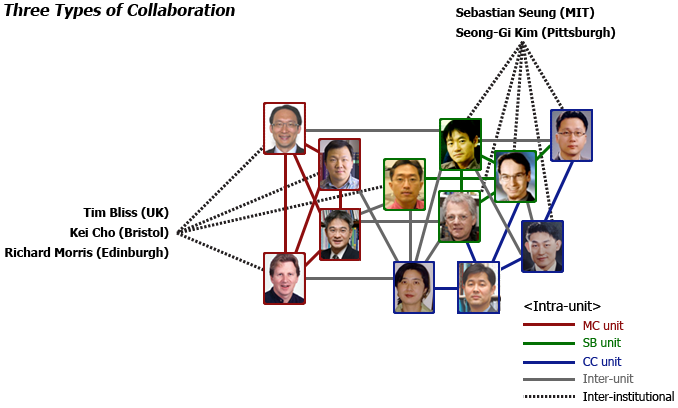Views
| Line 7: | Line 7: | ||
<html> | <html> | ||
<p align="center"> | <p align="center"> | ||
| - | |||
<img src="/preview/img/three_collaboration.png"></p> | <img src="/preview/img/three_collaboration.png"></p> | ||
</html> | </html> | ||
Revision as of 08:24, 2 April 2009
Contents |
The Three Core Research Units
To execute our strategic plan (SLBM) effectively, hosting scholars at SNU and invited international scholars will form teams organized around three core research units.
Network of Collaborations

Molecule to Cognition unit
The long-term goal of this unit is to elucidate the molecular and synaptic bases of learning and memory and to establish how alterations in synaptic plasticity contribute to neurological and psychiatric disorders. This unit will study how genetic/molecular/synaptic/neuronal/local circuit-level brain mechanisms (red squares in Fig 1A and red rectangles in Fig 2A) enable cognitive faculties such as memory, learning, emotion, and sensation by integrating neurometric techniques at different depths (from genetic manipulation to live cell imaging, red squares in Fig 1C) with psychometric techniques such as maze learning tasks and behavioral genetics. Bong-Kiun Kaang (Table 1A-1) will lead this unit joined by Graham Collingridge, Min Zhuo and Sang Jeong Kim (Table 1A-2~4).

Bong-Kiun Kaang, Dept of Biological Sciences, SNU
Bong-Kiun Kaang
- One of the key leading neurobiologists in Korea with expertise on the molecular mechanism of synaptic plasticity and memory from multiple model systems such as Aplysia and mouse.
- His recent work on the molecular, cellular mechanism of synaptic plasticity and fear memory is providing a new view, unveiling novel, original molecular mechanisms of memory.
- High impact publications in Cell, Science, Neuron, PNAS.
- Papers on the functional implication of cAMP-PKA-CREB signaling pathway in Aplysia neurons, in collaboration with Dr. Eric Kandel (year 2000 Nobel Laureate, also his lifelong collaborator), had a great impact on molecular neurobiology field (Neuron, 1993; Science, 1993).
- Director of National Creative Research Initiative Center for memory; Editor-in-chief of on-line neuroscience journal, Molecular Brain.

Graham Leon Collingridge FRS, MRC Centre for Synaptic Plasticity, U of Bristol
Graham Leon Collingridge FRS
- Investigating the synaptic basis of learning and memory with an emphasis on the role of glutamate receptors in hippocampal long-term potentiation (LTP) and long-term depression (LTD).
- He established the principle that NMDA receptors trigger plasticity and AMPA receptors mediate a modifiable synaptic response, and this principle has now been extended to many other synapses in the brain and is regarded as one of the most influential discoveries in the field of synaptic function.
- Discovered that NMDA receptor-mediated synaptic transmission is plastic; synaptic plasticity is expressed by changes in AMPA receptor function; both inhibitory and facilitatory autoreceptor mechanisms contribute to the acute and long-term regulation of synaptic transmission.
- High impact publications including Collingridge et al(1983, J of Physiology, over 1,500 citations) and Bliss & Collingridge (1993, Nature, over 5,000 citations).
- Numerous prestigious awards including Elected Fellow, The Royal Society (2001); Elected President, British Neuroscience Association (2007). The Santiago Grisolia Prize (2008).

Min Zhuo, Dept of Physiology, U of Toronto
Min Zhuo
- His lifelong works on the molecular mechanism of chronic pain and the role of ACC in chronic pain is highly creative and exceptional.
- His original findings about the role of CNS on the generation of chronic pain sensation shed light on the field of chronic pain research.
- Expert on brain pharmacology and molecular mechanism of chronic pain (consulting experience with Big Pharmas such as Pfizer)
- Having high-profile publication records (4 Nature, 3 Nature Neuroscience, 5 Neuron, 1 Science, and total SCI 157 papers within 20 years of research)
- His research goal is to unravel the molecular mechanism of chronic pain and emotion-related brain disorders.
- Founding editor and Editor-in-chief of online neuroscience journal Molecular Pain (Impact factor 4.13, top 20% among Neuroscience journals) and Molecular Brain.

Sang Jeong Kim, Dept of Physiology, SNU College of Medicine
Sang Jeong Kim
- Research focus on the cellular and molecular mechanisms of information storage and its related brain diseases by combining cutting-edge techniques such as patch clamping, Ca imaging, confocal microscopy, UVphotolysis and field/single unit recording from isolated neurons, brain slices and in-vivo animals.
- High impact publications in major journals such as Nature, Neuron, and Journal of Neuroscience, etc, making over 300 score of the total impact factor during last five years.
- Published a comprehensive review article in Neuron suggesting that ubiquitous synaptic plasticity is necessary to account for the rich phenomenon of memory storage in the neural network.
- Editorial board of the Journal of Neurophysiology.
System and Behavior Neuroscience unit
The long-term goal of this unit is to understand neuronal mechanisms involved in the encoding of sensory inputs, the representation and decoding of relevant information from populations of active neurons, and the maintenance and retrieval of information within those populations. This unit will study how neuronal/local circuit/global circuit-level brain mechanisms (green triangles in Fig 1A and green rectangles in Fig 2A) enable cognitive processes such as sensation, perception, memory, decision making and attention (green triangles in Fig 1B); the aim is to integrate neurometric techniques including single/multi-unit cell recordings, micro/macro-brain imaging and brain stimulation (green triangles in Fig 1C) with psychometric techniques encompassing various forms of perceptual and memory tasks (green triangles in Fig 1D). Computational approaches will play a major role in bridging studies from individual researchers with expertise using different types of measurement (Fig 1E). Sang-Hun Lee (Table 1B-1) will lead this unit teamed up with Randolph Blake, Inah Lee and Marcus Kaiser (Table 1B-2~4).

Sang-Hun Lee, PhD, Dept. of Psychology, SNU
Sang-Hun Lee
- An expert in visual neuroscience with specialty in parallel uses of fMRI, psychophysics and neural models linking psychophysical and cortical measurements.
- High impact publications in journals such as Science, Nature, Nature Neuroscience.
- His recent work on traveling waves in human visual cortex (Nature, 2001; Nat. Neurosci, 2005; 2007) has created great impacts in the fields of both visual neuroscience and neural basis of consciousness.
- His work on the role of temporal structure in spatial grouping (Science, 1999) is highly original and has sparked keen interest in that topic.
- Recipient of ASSC William James Award (2006) in recognition of his contribution to scientific studies of consciousness
- Unit leader and representative PI of DBCS.

Randolph Blake, PhD, Dept. of Psychology, Vanderbilt University
Randolph Blake
Randolph Blake, PhD, Dept. of Psychology, Vanderbilt University
- Studying important aspects of perception by blending psychophysics, neural modeling and brain imaging.
- Acknowledged as world's expert on rivalry and perceptual bistability.
- Devised clever, revealing "psychoanatomical" strategies for identifying neural sites of action within human vision
- Blake's work on the role of temporal structure in spatial grouping is highly original and has sparked keen interest in that topic.
- His 1989 Psychological Review paper on rivalry, the most widely cited theoretical paper on that topic, stimulated an explosion of interest in the phenomena within cognitive neuroscience and neurophysiology.
- High impact publications in Nature (13), Science(9); H research impact factor is 36
- Coauthor of a widely used textbook on perception (Blake & Sekuler, 2005, Perception, McGraw-Hill) now in its fifth edition.
- Numerous prestigious awards including Elected Fellow, American Academy of Arts and Science 2006; Earl Sutherland Award, 2000; APA, Early Career Award, 1977; Thomas Jefferson Award, 2008; IgNobel Prize, 2006.

Inah Lee, PhD, Dept. of Psychology, U of Iowa
Inah Lee
- His research aim is to elucidate biological mechanisms of episodic memory and rule learning using electrophysiology, behavioral neuroscience, neuropharmacology and computational modeling.
- High impact publications in high-profile journals such as Nature, Nature Neuroscience and Neuron.
- His work in Nature (2004) provided, for the first time, that neurons in the hippocampus perform a computational function, pattern completion, that had only been suggested by theoreticians and computational modelers for more than 30 years without any experimental proof.
- His publication record within a short period of time of 7 years is exceptional in the field of systems neuroscience involving animal experiments.
- Full-time commitment for 5 years.

Marcus Kaiser, PhD, Complex Neural Systems, Newcastle Univ.
Marcus Kaiser
- His research interest is modeling network architecture and simulating neural activity as well as data analysis of experimentally observed brain connectivity and neural dynamics.
- High impact publications in journals such as Neuron, PLoS CB, Trends in Cognitive Sciences and Physical Review within 4 years
- The first to show that local spatial and topological features of cortical and neuronal networks can be used to reconstruct the global network topology.
- The first to publish that cortical networks can show sustained activity that neither dies out nor spreads through the whole network even in the absence of inhibitory nodes.
Clinical Neuroscience and Computational Anatomy unit
The long-term goal of this unit is to understand psychiatric disorders, with an eye toward identifying means for correcting those disorders or minimizing their consequences. Furthermore, work carried out in this unit will promote development of computational and mathematical tools for handling neuroimaging data analyses which, in turn, will contribute to integrative evaluation of functional, structural and biochemical aspects of the brain, both disordered and healthy. This unit, led by Jun Soo Kwon (Table 1C-1), consists of two subunits. The ‘Clinical Neuroscience’ subunit, comprising Jun Soo Kwon and Sohee Park (Table 1C-2), will focus on studies of the pathophysiology of mental/brain disorders, including schizophrenia, depression, bipolar disorder and obsessive-compulsive disorder (Fig 1F), they will deploy an integrative set of neurometric (large-scale brain imaging techniques on human brains, blue circles in Fig 1C) and psychometric (various forms of high cognitive tasks, blue circles in Fig 1D) measurement tools. The ‘Computational Anatomy’ subunit, led by the collaboration between Jae Sung Lee and Moo K. Chung (Table 1C-3,4), will integrate neurometric data obtained from functional (fMRI, PET) and structural (DTI, MRI) images - major large-scale neurometric data from humans in modern cognitive neuroscience (Fig 1C) - into a single, coherent processing and analysis framework. The successful development of such tools will substantially help the other units to advance understanding of cortical and subcortical circuitries crucial for the target cognitive functions.

Jun Soo Kwon, MD, PhD, Dept. of Psychiatry, SNU
Jun Soo Kwon
- An expert in pathophysiology in the neuropsychiatric disorders such as schizophrenia and obsessive-compulsive disorder.
- Extensive publications in journals such as Arch Gen Psychiatry and Brain etc. marking over 80 score of the total impact factor during the last three years.
- Elected to be councilor in Collegium Internationale Neuro-Psychopharmacologicum (CINP) first in Korea
- Unit leader.

Sohee Park, PhD, Dept. of Psychology, Vanderbilt University
Sohee Park
- Research aim is to elucidate the neural origins and behavioral consequences of psychotic disorders.
- Experiences in utilizing multiple techniques to examine components of memory, attention and social deficits in psychiatric patients.
- Intensive records of collaboration with R Blake and JS Kwon.
- Maintaining active projects funded by federal agencies and private since 1991.
- Full-time commitment for 3 years.

Jae Sung Lee, PhD, Dept. of Nuclear Med. and Biomedical Sci., SNU
Jae Sung Lee
- Research aim is to develop innovative tools to analyze biomedical image data.
- Developed novel gamma-ray detectors which allow PET images with very high resolution and sensitivity (IEEE TNS, 2008).
- Developing an experimental system for truly simultaneous PET/MR imaging.
- Recipients of Young Investigator's Award, Korean Society of Medical and Biological Eng./Nucl. Med./ Human Brain Mapp. (2004).

Moo K. Chung, PhD, Dept. of Biostatistics & Medical Informatics, U of Wisconsin-Madison
Moo K. Chung
- The algorithm and code presented in his 2005 NeuroImage paper is the most widely used cortical data smoothing technique at this moment.
- Chung's cortical surface data filtering technique has been the standard to be compared and to be validated against in the field.
- His 2001 NeuroImage paper on tensor-based morphometry was the first paper that shows the Jacobian determinant is the only meaningful metric in structural imaging.









